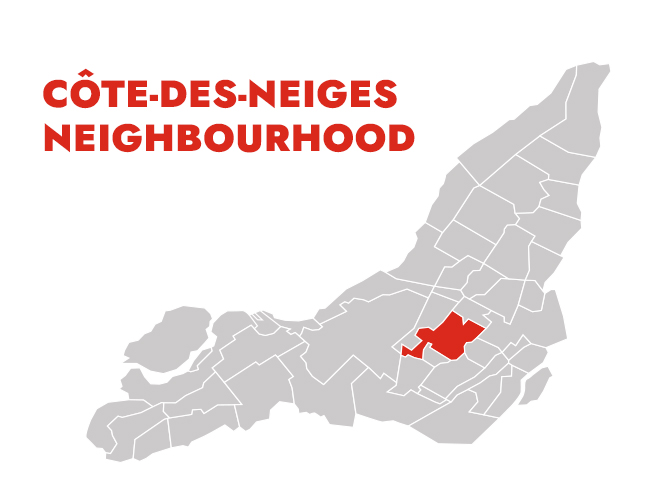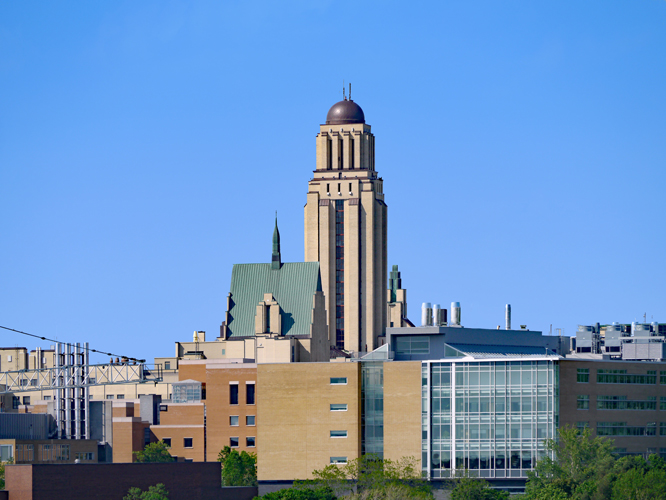A brief history
During the first two centuries of its history, Côte-des-Neiges was a small, slow-growing village of tanners and farmers. However, at the beginning of the 20th century, the pace of its growth increased dramatically. Over a period of sixty years, institutions and residential housing took over the area, erasing all traces of the former village. A services economy, centred around the health and education sectors, replaced the rural economy and established itself as the neighbourhood’s driver of economic growth until the early 21st century. The population soared and diversified, and the “little French village” quickly became the “borough of 110 languages.” The multicultural composition of Côte-des-Neiges continues to this day.
Over the years, residents took various steps to improve their living conditions. They came together to provide services, break social isolation, develop recreation activities, fight for causes, and defend their rights. The close involvement of residents allowed community agencies to become key players in the social development of neighbourhoods. The people of Côte-des-Neiges made the neighbourhood what it is today: a borough that faces many challenges, yet is strengthened by a wealth of culture and community spirit.1
[1] Source Conseil CDN: https://www.conseilcdn.qc.ca/wordpress/wp-content/uploads/2013/09/Histoire_Cotes_Des_Neiges-4.pdf

The area and its population
Côte-des-Neiges is bordered on the northeast by the borough of Outremont and the town of Mount Royal; the borough of Saint-Laurent to the northwest; the towns of Hampstead and Côte-Saint-Luc to the west; and the Notre-Dame-de-Grâce neighbourhood and the municipality of Westmount to the south. Constructed in 1966, the Décarie Expressway represents a fracture to the urban fabric of the neighbourhood. Côte-Sainte-Catherine Road delineates the upper and lower municipalities of Côte-des-Neiges. Administratively, the boroughs of Côte-des-Neiges and Notre-Dame-de-Grâce amalgamated in 2002 to become the borough of Côte-des-Neiges–Notre-Dame-de-Grâce.
Côte-des-Neiges is a culturally and socially diverse neighbourhood, yet one that faces considerable challenges in terms of inclusion, access to resources and public services, decent housing, and quality employment opportunities.
One neighbourhood, two realities
There is a stark contrast between the various sectors, caused in part by poor urban planning, as well as the socio-economic divisions between Upper and Lower Côte-des-Neiges, which is divided by Côte-Sainte-Catherine Road. Commonly called Upper Côte-des-Neiges, Côte-des-Neiges-Sud is home to students and institutions. The population is highly educated, a high number of people live alone (23% compared to 16% in Lower Côte-des-Neiges), and residential mobility is high.
Around 60% of the borough’s population lives in Côte-des-Neiges-Nord, commonly called Lower Côte-des-Neiges. A higher concentration of immigrants, allophones, visible minority groups, and twice as many families with children live in this area compared to Côte-des-Neiges-Sud.
Living standards and diversity
The high number of low-income residents (29,380, one-third of the population) in Côte-des-Neiges poses major challenges. Poverty is most pronounced in terms of material disadvantages, while the unemployment rate remains higher than the Montreal average, and the average income is among the lowest on the Island. One in five workers, representing nearly 5,000 people, is a low-paid worker, making the borough the home to the highest proportion of low-paid workers in Montreal.
However, the neighbourhood has several strengths, including a relatively young, educated population, several regional institutions (universities and hospitals), a multitude of community resources, and a University Health and Social Services Centre (CIUSSS), which has become extremely well-versed in working with a multiethnic population. In fact, more than half of the population (54%) is a member of a visible minority group (Montreal: 33%). And nearly half of the population is allophone: 46% have a mother tongue other than French or English (Montreal: 33%).
Centraide’s investments in the neighbourhood
In line with its regional approach, Centraide of Greater Montreal closely follows and pays particular attention to financing requests that aim to address challenges in the Côte-des-Neiges area.
Special attention is directed at programs and projects that maximize investments and increase community capacity to respond to the social challenges of combatting poverty. These issues include:
- Mobilization and strategic planning in the area;
- Collaborative action in vulnerable sectors;
- Housing, a complex and unavoidable issue;
- Diversity and inclusion;
- And support for vulnerable families.
to support
youth success
to take care
of the essentials
to break
social isolation
to build
caring communities
*2018-2019 Data
Examples of initiatives in the neighbourhood
Beyond working to find long-term solutions, agencies supported by Centraide are leaders in their fields and a force for change.
Agencies supported by Centraide
Centraide of Greater Montreal supports 14 agencies in the borough of Côte-des-Neiges that work to improve living conditions, community development, inclusion, neighbourhood life, and support young people and families.
- Corporation de développement communautaire de Côte-des-Neiges
- Organisation d’éducation d’information logement de Côte-des-Neiges (ŒIL)
- Préventionn Côte-des-Neiges-Notre-Dame-de-Grâce
- Project Genesis
- PROMIS (PROMotion, Intégration, Société nouvelle)
- Service d’interprète d’aide et de référence aux immigrants (SIARI)




